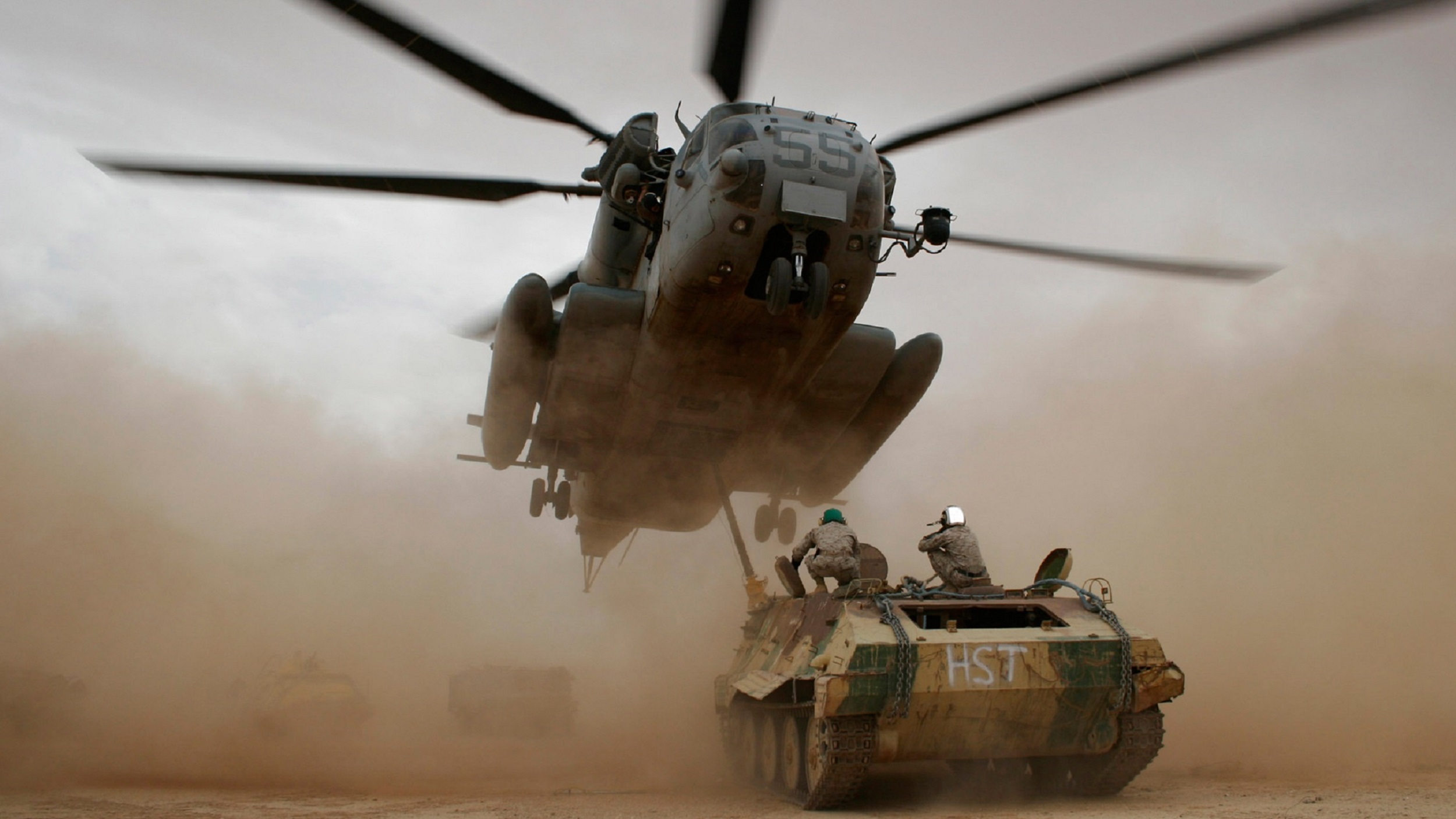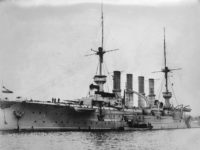The large cruiser SMS Roon belonged to the same ship class, which consisted of only two ships and were built shortly after the turn of the century. These ships provided the transition from the class of armored cruiser to the big cruiser.
Launching and design:
At the beginning of the 20th century, a draft was required by the German naval office to replace the two ships of the Kaiser class of 1874. End of 1901, the design was firmly established, which was strongly based on the just recently designed Prinz Adalbert class. The most striking differentiator was instead of 3, now 4 chimneys. Due to the installation of 16 water tube boiler another chimney was needed. The Prinz Adalbert class, on the other hand, was designed with 14 Dürr steam boilers, which required less space in the ship.
The launching of SMS Roon took place on June 27, 1903, the commissioning on April 5, 1906.

The SMS Brandenburg and the SMS Roon at the end of the autumn manoeuvres 1906. The Roon carries the white tropical coat of paint as emperor's escort ship.
History of SMS Roon:
After the commissioning and the subsequent test drives, the Roon was assigned to the reconnaissance forces and participated together with other ships in the annual fleet maneuvers.
In 1907, the ship also served as a troop transport for soldiers who were brought from Germany to the German colony to Tsingtao in Asia. A visit to the US led the ship in the same year as well.
As on March 20, 1908, the British battlecruiser HMS Invincible and on February 19, 1911, the German battlecruiser SMS Von der Tann Indienst was made, these new ship types were superior to the older armored cruisers in speed and in firepower. During the year 1911, SMS Roon was therefore decommissioned and assigned to the reserve fleet.
Use in the war:
With the outbreak of the First World War, the SMS Roon was reactivated and the III. Assigned to reconnaissance group as flagship.
From 30 June to 2 July 1915, the Roon was involved in the German advance near the island of Gotland, where it survived several battles with Russian armored cruisers slightly damaged.
Since the Roon, like other older ships, had no or only an insufficient underwater protection against submarines and mines, the ship was decommissioned in 1916 and initially used as a barge in Kiel.
Whereabouts:
As the war progressed, naval planning began rebuilding the Roon as a naval aircraft carrier. In the middle of 1918, the conversion was started, but this set back a short time later completely, because the Marineamt had opted for a real aircraft carrier.
After the capitulation of the German Empire, the Roon did not have to be interned like most other ships or be delivered to the victorious powers.
During the year 1920, the SMS Roon was finally decommissioned and deleted on November 25, 1920 from the list of warships. From 1921 began in Kiel scrapping.
Ship data:
| Name: |
SMS Roon |
| Country: |
German Empire |
| Ship Type: |
Big cruiser |
| Class: |
Roon-Class |
| Boatyard: |
Imperial shipyard, Kiel |
| Building-costs: |
15.345.000 Mark |
| Launched: |
June 27th, 1903 |
| Commissioning: |
April 5th, 1906 |
| Whereabouts: |
From 1921 scrapped in Kiel |
| Length: |
127,8 meters |
| Width: |
20,2 meters |
| Draft: |
Max. 7,3 meters |
| Displacement: |
Max. 10.266 Tons |
| Crew: |
633 Men |
| Drive: |
16 water tube boiler type Dürr |
| Power: |
20.625 PS (15.170 kW) |
| Maximum speed: |
21,1 kn (39 km/h) |
|
Armament: |
4 × Rapid Fire Gun 21,0 cm L / 40 (380 shots) 10 × Rapid Fire Gun 15,0 cm L / 40 (1.600 shots) 14 × Rapid Fire Gun 8,8 cm L / 35 (2.100 rounds) 4 × torpedo tube ø 45,0 cm (under water, 11 rounds) |
| Armor: |
Belt: 80-100 mm on 55 mm teak |
You can find the right literature here:
German Battleships 1914–18 (1): Deutschland, Nassau and Helgoland classes (New Vanguard)

German Battleships 1914–18 (1): Deutschland, Nassau and Helgoland classes (New Vanguard) Paperback – February 23, 2010
Supported by official documents, personal accounts, official drawings and specially commissioned artwork, this volume is an enlightening history of the Deutschland to Osfriesland classes. Detailing the last of the pre-dreadnaught battleship classes, this book goes on to explain the revolutionary developments that took place within the German Imperial Navy as they readied themselves for war. This included creating vessels with vast increases in size and armament. This account of design and technology is supplemented by individual ship histories detailing combat experience complete with first-hand accounts. The specially commissioned artwork also brings this history to life with recreations of the battleship Pommern fighting at Jutland and ships of the Osfriesland class destroying HMS Black Prince in a dramatic night-time engagement.
The Imperial German Navy of World War I, Vol. 1 Warships: A Comprehensive Photographic Study of the Kaiser’s Naval Forces

The Imperial German Navy of World War I, Vol. 1 Warships: A Comprehensive Photographic Study of the Kaiser’s Naval Forces Hardcover – December 28, 2016
The Imperial German Navy of WWI is a series of books (Warships, Campaigns, & Uniforms) that provide a broad view of the Kaiser's naval forces through the extensive use of photographs. Every effort has been made to cover all significant areas during the war period. In addition to the primary use of photographs, technical information is provided for each warship along with its corresponding service history; with a special emphasis being placed on those warships that participated in the Battle of Skagerrak (Jutland). Countless sources have been used to establish individual case studies for each warship; multiple photos of each warship are provided. The entire series itself is unprecedented in its coverage of the Kaiser's navy.
German Battlecruisers of World War One: Their Design, Construction and Operations

German Battlecruisers of World War One: Their Design, Construction and Operations Hardcover – November 4, 2014
This is the most comprehensive, English-language study of the German Imperial Navy's battlecruisers that served in the First World War. Known as Panzerkreuzer, literally "armored cruiser," the eight ships of the class were to be involved in several early North Sea skirmishes before the great pitched battle of Jutland where they inflicted devastating damage on the Royal Navy's battlecruiser fleet. This book details their design and construction, and traces the full service history of each ship, recounting their actions, drawing largely from first-hand German sources and official documents, many previously unpublished in English.
The Kaiser's Battlefleet: German Capital Ships 1871-1918
The battleships of the Third Reich have been written about exhaustively, but there is little in English devoted to their Second Reich predecessors. This new book fills an important gap in the literature of the period by covering these German capital ships in detail and studying the full span of battleship development during this period. The book is arranged as a chronological narrative, with technical details, construction schedules, and ultimate fates tabulated throughout, thus avoiding the sometimes disjointed structure that can result from a class-by-class approach. Heavily illustrated with line drawings and photographs, many from German sources, the book offers readers a fresh visual look at these ships. A key objective of the book is to make available a full synthesis of the published fruits of archival research by German writers found in the pre-World War II books of Koop & Schmolke, Großmer's on the construction program of the dreadnaught era, Forstmeier & Breyer on World War I projects, and Schenk & Nottelmann's papers in Warship International. As well as providing data not available in English-language books, these sources correct significant errors in standard English sources.
This post is also available in:
 Deutsch (German)
Deutsch (German)  Français (French)
Français (French)  Italiano (Italian)
Italiano (Italian)  简体中文 (Chinese (Simplified))
简体中文 (Chinese (Simplified))  Русский (Russian)
Русский (Russian)  Español (Spanish)
Español (Spanish)  العربية (Arabic)
العربية (Arabic)













